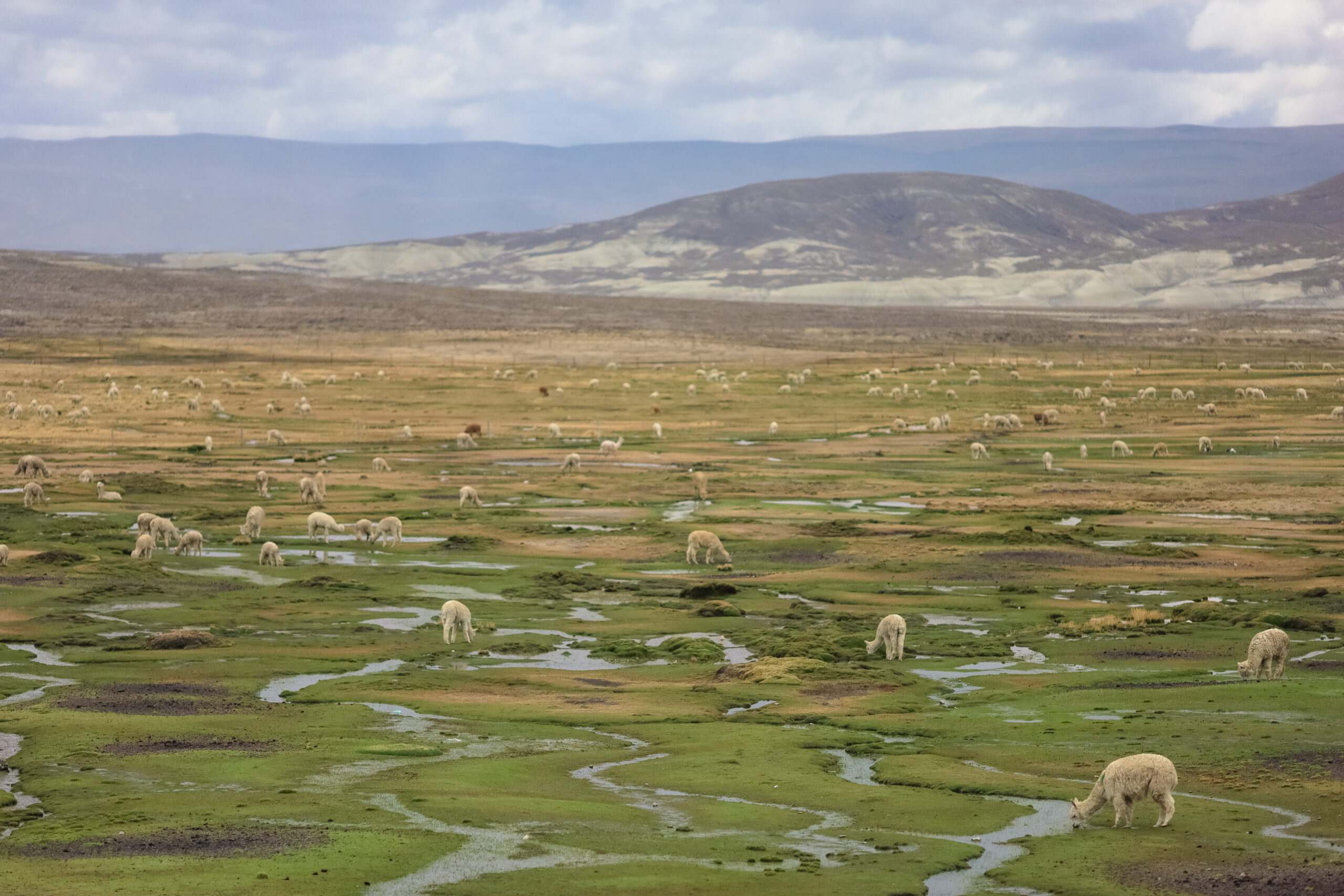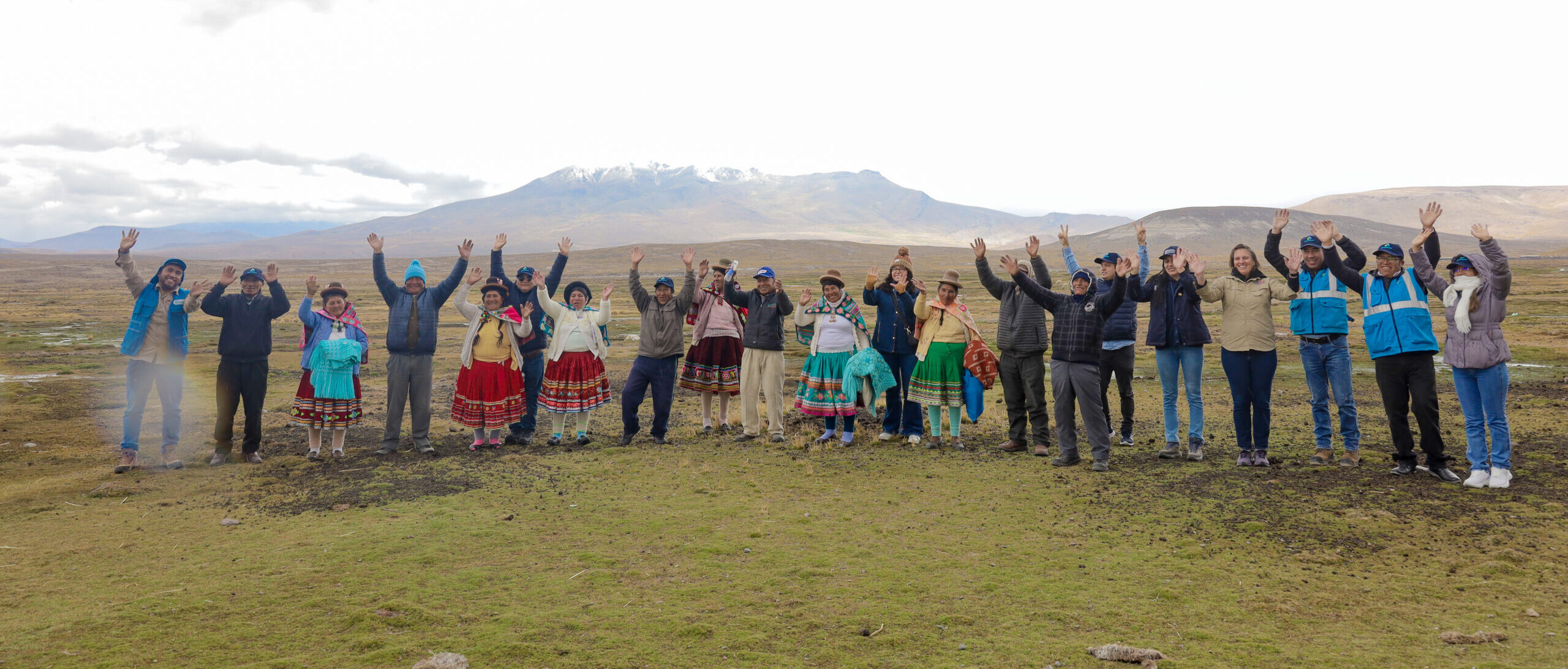At nearly 14,000 feet above sea level in the mountains of southern Peru, people in the San Juan de Tarucani district in the Arequipa region are facing a water crisis. Wetlands and lagoons in the area are usually replenished during the rainy season (December through March), but in the face of lower rainfall associated with climate change, these critical water sources are drying up. And this doesn’t only affect people in San Juan de Tarucani; the community is near the head of the Chili River, which supplies drinking water to the over one million inhabitants of the city of Arequipa.

Without these wetlands and lagoons, the entire region loses the natural water storage these ecosystems provide throughout the much longer dry season, threatening peoples’ water sources for almost 10 months of the year. Without reliable access to water, people throughout the region will struggle to meet basic needs for things like drinking water, food preparation, agriculture, and sanitation. For the people of San Juan de Tarucani, access to water is also critical to sustaining their only source of income: raising llamas and alpacas.
Water crises like this aren’t unique to Peru. Ecosystems, like the wetlands in San Juan de Tarucani that are the foundation of community survival, are in decline around the world. Climate change is already changing weather patterns and water availability, resulting in more extremes in the form of droughts, floods, landslides, and water pollution. Take the Southwestern US, for example. Forty million people in seven states depend on water from the Colorado River for household use and growing food. As the region continues to dry out, people are using up the remaining water much faster than it can be replenished. This is causing major conflict between cities and towns and farmers.
While water scarcity can be a source of division, it can also be an opportunity to come together. Some regions in Peru have been discovering the power of water as a way to unite and show up to the problem-solving table a little differently. Seeing water as a collective responsibility, rather than simply a “water utility problem,” opens the door for diverse perspectives and buy-in from other sectors – collaborations every country will need to navigate water crises in a changing climate. With support from Forest Trends and our partners, people in the Arequipa region were supported to build such a coalition and recognize their shared dependence on a dwindling resource.
The path to building these partnerships was not straightforward, though. Several years ago, as part of a national policy reform, the city of Arequipa’s water utility, SEDAPAR, began collecting money through a water tariff. They planned to use this money to address threats to the city’s water supply. What quickly became unclear was exactly what kind of projects the money should be spent on to best support everyone who depends on the Chili River in the long term.
Upriver from the city of Arequipa, Peru’s National Park Service (SERNANP) and a local NGO, DESCOSUR, were conserving and restoring ecosystems in Peru’s Salinas and Aguada Blanca National Reserve, with local communities like the one in San Juan de Tarucani. Their problem was the opposite of SEDAPAR’s: lots of specific plans and ideas, but not enough funding and other resources to follow through.
Since its launch in 2017, the Natural Infrastructure for Water Security (NIWS) Project, led by Forest Trends and supported by the US Agency for International Development (USAID) and Canada, has been working closely with partners in Peru to put in place nature-based solutions (NBS) that can help people replenish and sustain their water supplies in the face of a changing climate. Nature-based solutions include investments that conserve and restore critical natural infrastructure such as forests, wetlands, grasslands, and mangroves, instead of building infrastructure, like treatment plants or dams.
With support from NIWS, all of these stakeholders across Arequipa began to see how their goals were complementary and that they could collaborate to meet them. The actors realized that the money collected by SEDAPAR could be used to fund nature-based solutions projects in the Salinas and Aguada Blanca National Reserve as a way to protect the region’s main water source for residents of the Reserve and communities downstream. SEDAPAR, SERNANP, and DESCOSUR agreed that a partnership was the best solution.
The final obstacle was creating a pathway for this funding to flow from SEDAPAR to local communities like San Juan de Tarucani. To overcome this, NIWS helped set up an innovative agreement with these actors and Peru’s national protected areas fund, PROFONANPE, so that funds for nature-based solutions projects could be sent from SEDAPAR to project implementors in the Salinas and Aguada Blanca National Reserve.
Once funding started flowing, this partnership began working with people in San Juan de Tarucani to restore local wetlands and build permeable “micro-reservoirs” to increase year-round access to water and water quality in the Arequipa region. The “micro-reservoirs,” known as qochas in the indigenous Quechua language, collect and store water when it rains and then gradually release the water into the soil. This gives people a steadier supply of water for drinking and agriculture, even during a drought. Wetlands that have been restored can also store a great deal of water. This water can then seep into lakes, ponds, or aquifers, which store large amounts of freshwater underground. The restored wetlands also help filter any pollutants out of the water, reducing the cost of treatment needed for it to be safe to drink or water crops.
While the agreement between SEDAPAR, the parks service, and the protected areas fund set up the means for nature-based solutions projects in San Juan de Tarucani, it was the local people who came together to drive these efforts forward and who will continue to do so in the future. The community is collectively advocating for healthy ecosystems because they will help them thrive long-term by providing things like clean water and biodiverse landscapes that allow them to raise llamas and alpacas for income.
Filomeno Quispe, a park ranger for Peru’s National Park Service who lives in San Juan de Tarucani, observed that “community members are no longer requesting the construction of buildings or parks. Instead, they are requesting the construction of micro-reservoirs, canals, and fencing because these lead to healthier livestock and support their sources of income.” He added that, as a result of the project, “people in my community are now more aware that [investing in natural infrastructure is] necessary” to ensure water availability at home and for their livelihoods.
This project is evidence of the power of coalitions in the face of change and uncertainty. When the mountain community of San Juan de Tarucani, urban water users, a water utility, and parks service came together, it unlocked unique sources of funding and new ways for these groups to share knowledge and expertise. Many of today’s institutions are not set up to deal with today’s complex climate challenges, making relationships like this critical to helping the culture of our institutions shift towards more adaptable ways of problem solving in the face of great uncertainties. And this goes beyond Peru. The spirit of collaboration can thrive anywhere in the world. Water and other climate challenges don’t have to drive us apart; uniting over the resources and places we care about can help us create a more sustainable future, together.

##
This blog is made possible by the support of the American People through the United States Agency for International Development (USAID) and the Government of Canada. The contents of this blog are the sole responsibility of Forest Trends and do not necessarily reflect the views of USAID or the United States Government or the Government of Canada.
The Natural Infrastructure for Water Security (NIWS) project aims to scale up investments in natural infrastructure in Peru to safeguard water supplies and increase climate resilience. It is funded and promoted by the United States Agency for International Development and the Government of Canada.
Viewpoints showcases expert analysis and commentary from the Forest Trends team.
Connect with us on Facebook and Twitter to follow our latest work.
